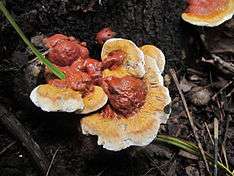Ganoderma sessile
| Ganoderma sessile | |
|---|---|
 | |
| Scientific classification | |
| Kingdom: | Fungi |
| Division: | Basidiomycota |
| Class: | Agaricomycetes |
| Order: | Polyporales |
| Family: | Ganodermataceae |
| Genus: | Ganoderma |
| Species: | G. sessile |
| Binomial name | |
| Ganoderma sessile Murrill (1902) | |
Ganoderma sessile is a species of polypore fungus in the Ganodermataceae family. It is a plant pathogen and occasional saprotroph similar in appearance to Ganoderma lucidum. This species is restricted geographically to the Midwest and Eastern United States, where it is very common on hardwoods.
Taxonomy
This fungus is a member of the G. resinaceum / G. lucidum group, and has previously been considered taxonomic synonyms of both species.[1][2]
Description
Ganoderma sessile is a perennial, sessile, concentrically zonate polypore that is 5–25 cm (2.0–9.8 in) in length. The top can be a number of shiny tones ranging from white at the edges to yellow and red at the center. Its spore surface is white but easily turns brown upon damage. It can be distinguished from the closely related Ganoderma curtisii by spore morphology. It parasitizes hardwoods.[3][4][5]
Uses
It is often used to make a tea-like infusion.
References
- ↑ Zhou, LW; Cao, Y; Wu, SH; Vlasák, J; Li, DW; Li, MJ; Dai, YC (2014). "Global diversity of the Ganoderma lucidum complex (Ganodermataceae, Polyporales) inferred from morphology and multilocus phylogeny.". Phytochemistry. 114: 7–15. doi:10.1016/j.phytochem.2014.09.023. PMID 25453909.
- ↑ Steyaert, R. L. (1 January 1980). "Study of Some Ganoderma Species". Bulletin du Jardin botanique national de Belgique / Bulletin van de National Plantentuin van België. 50 (1/2): 135–186. doi:10.2307/3667780. JSTOR 3667780.
- ↑ Mycologia. 11 (3): 102. 1919 http://www.cybertruffle.org.uk/cyberliber/59350/0011/003/0102.htm. Missing or empty
|title=(help) - ↑ Letters, Michigan Academy of Science, Arts, and (1 January 1905). Report of the Michigan Academy of Science ... State Printers.
- ↑ Murrill, William A. (1 January 1902). The Polyporaceae of North America ...
External links
- "Ganoderma sessile Murrill 1902". MycoBank. International Mycological Association. Retrieved 2015-04-05.
- Ganoderma sessile images at Mushroom Observer
- Ganoderma sessile in Index Fungorum